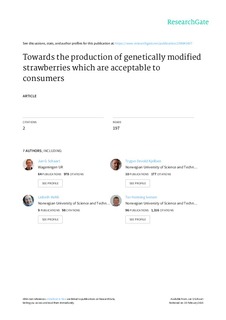Towards the production of genetically modified strawberries which are acceptable to consumers
Schaart, Jan G.; Kjellsen, Trygve Devold; Mehli, Lisbeth; Heggem, Reidun; Iversen, Tor-Henning; Schouten, Henk J.; Krens, Frans A.
Journal article, Peer reviewed
Date
2011Metadata
Show full item recordCollections
- Institutt for biologi [2526]
- Institutt for bioteknologi og matvitenskap [1552]
- Publikasjoner fra CRIStin - NTNU [37703]
Original version
Genes, Genomes and Genomics 2011(5):102-107Abstract
This manuscript discusses different aspects that are relevant to genetically modified strawberry plants with improved characteristics and
‘acceptable’ to consumers and growers of strawberry. It starts with a consumer acceptance survey, held in Norway, Denmark and the UK,
studying public perception of genetic modification in general and specifically of genetically modified strawberries with altered properties.
This study revealed that genetically modified plants are better accepted by consumers if only genes from the species itself are used for the
genetic modification. Subsequently, the results of a functional analysis of the strawberry polygalacturonase inhibiting protein gene
(FaPGIP) are described. This indicates that this gene is a possible candidate to induce resistance to Botrytis cinerea when upregulated in
strawberry fruits. For this analysis, the FaPGIP gene was overexpressed in transgenic strawberry plants using the cauliflower mosaic
virus 35S (CaMV35S) promoter. This showed that FaPGIP overexpression led to resistance to Botrytis in transgenic leaves. For the
generation of intragenic (i.e. genetically modification using native genetic elements only) strawberry plants, a transformation vector was
constructed in which FaPGIP was combined with a strawberry fruit-specific promoter and terminator that were isolated from a strawberry
expansin gene (FaExp2). This vector also included elements that allow the elimination of (foreign) selectable marker genes after
genetically modified plant lines have been established. Using this vector, genetically modified strawberry plants were produced that
contained only genes from the species itself, and therefore these plants were called intragenic, rather than transgenic. Unfortunately,
further evaluations of the intragenic strawberry plants could not demonstrate any enhanced level of resistance to Botrytis in fruits.
